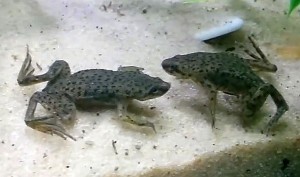The Congo Dwarf Clawed Frog (Hymenochirus boettgeri) is by far the most common species of aquatic frog sold to tropical fish keeping enthusiasts in the pet trade. They are distributed throughout the Democratic Republic of the Congo, Gabon, Cameroon, and Nigeria.
The Hymenochirus genus contains two species (Hymenochirus boettgeri and Hymenochirus curtipes) and possibly a subspecies that all look similar and share some common characteristics.
Both species are brown to gray with small spots on their backs; have flat, circular, lidless eyes that sit on the sides of their tapered heads; lack tongues, and have webbed front and rear feet. Both H. boettgeri and H. curtipes are unusual in that they never need to leave the water, in fact they will dry out and die if they do. The major difference between the two species is that H. curtipes has a much “wartier” skin.
The Congo Dwarf Clawed Frog‘s small size and docile temperament makes it well suited for peaceful community aquariums of all sizes. The males are slimmer than the females and have a small gland that looks like a little pimple behind both of their front legs. Only the males are able to sing or hum to apparently attract a mate. Mature females are a bit larger than the males, and become almost pear shaped, particularly when their abdomens are filled with eggs.
The Congo Dwarf Clawed Frog is best housed in a densely planted aquarium of at least 10 gallon capacity, with a medium gravel substrate, some driftwood or bogwood and rock work for them to hide among, and if setting up a single species biotope tank, a layer of Indian Almond Leaves
on the bottom. Because they are largely a nocturnal species, subdued lighting or floating plants
along with a moderate filtration system with little to no current, and a tightly fitting tank cover to prevent escapes, is recommended.
Although the Congo Dwarf Clawed Frog can thrive in a community tank environment, some care must be taken to prevent the other fish in the tank from starving the frogs to death.
Congo Dwarf Clawed Frogs mate during what is called amplexus, which usually occurs at night after several nights of “singing courtship” by the male.
When ready to mate, the male will grasp the female around the abdomen, just in front of her hind legs. During the mating ritual, the female does all the swimming and tows the male around until she is ready to lay her eggs, one at a time, on the surface of the water. As the eggs are laid, the male releases sperm into the water to fertilize the eggs. When spawning is complete, the female will become motionless, signaling the male to release her. After a few minutes the male will get the hint and release the female.
Feeding Congo Dwarf Clawed Frogs their preferred diet of live or frozen bloodworms, tubifex, or chopped earthworms can be a task if they are kept in a community tank. They detect their food visually by movement, and unless they are individually fed, the other fish in the tank will usually eat up their share of the food.
Because they have no teeth, they cannot chew their food; instead they aggressively strike out at their prey and piggishly gulp it down whole. Many tropical fish keeping enthusiasts hand feed their frogs or use modified turkey basters to place the food in front of their pets. Whichever method you use, take care not to overfeed your frogs. They will search the bottom of the tank and gorge themselves on every piece of food they can find until their bellies look like small golf balls. It’s better to feed them every couple of days or so with just enough food to round out their bellies.
Note: Some tropical fish keeping enthusiasts report that feeding freeze dried bloodworms or tubifex has caused intestinal blockages in their frogs which is usually fatal. Caution should be exercised.
Dwarf African Frogs are commonly available for purchase at reasonable prices when they are 1/2″ to 1-1/4″ in size.
Minimum Tank Size: 10 gallons
Care Level: Easy
Temperament: Docile
Aquarium Hardiness: Hardy
Water Conditions: 72-82° F, KH 5-8, pH 6.8-7.8
Max Size: 1½”
Color Form: Brown, Gray
Diet: Omnivore
Compatibility: Community tanks
Origin: Congo, Africa
Family: Pipidae
Life Span: 5-15 years
Aquarist Experience Level: Beginner




One Response to “Congo Dwarf Clawed Frog (Hymenochirus boettgeri)”
Trackbacks/Pingbacks
[…] Hymenochirus genus contains two species; the Dwarf African Frog (Hymenochirus curtipes) and the Congo Dwarf Clawed Frog (Hymenochirus boettgeri) and possibly a subspecies that all look similar and share some common characteristics. The […]